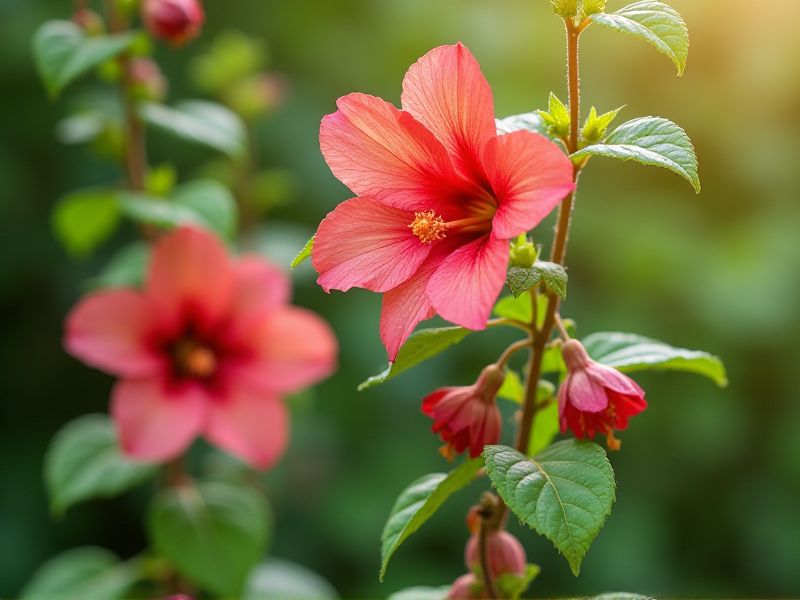
Climbing plants that flower can transform any garden or outdoor space with their vibrant colors and unique structures. Popular options include the clematis, known for its large, captivating blooms that vary in color from deep purple to bright white. Bougainvillea offers a stunning display of paper-like bracts in shades of magenta, fuchsia, and orange, thriving in sunny climates. The sweet-smelling honeysuckle attracts pollinators while producing delicate trumpet-shaped flowers, perfect for trellises or arbors. For your garden, consider incorporating these varieties to not only add visual interest but also support local ecosystems.
List of some Climbing plants that flower
- Wisteria (Wisteria sinensis)
- Clematis (Clematis spp.)
- Honeysuckle (Lonicera spp.)
- Bougainvillea (Bougainvillea spp.)
- Climbing Rose (Rosa spp.)
- Passion Flower (Passiflora spp.)
- Jasmine (Jasminum spp.)
- Trumpet Vine (Campsis radicans)
- Morning Glory (Ipomoea spp.)
- Sweet Pea (Lathyrus odoratus)
Important things about Climbing plants that flower
Types Of Climbing Plants
Climbing plants that flower, such as clematis and passionflower, add vibrant color and beauty to gardens and landscapes. These plants often require support structures like trellises, fences, or arbors to showcase their impressive blooms effectively. Varieties like wisteria and honeysuckle not only produce stunning flowers but also attract pollinators, enhancing the ecological value of your outdoor space. When choosing flowering climbers, consider factors like bloom time, color, and growth requirements to create a stunning, long-lasting display.
Growing Conditions
Climbing plants that flower thrive in a variety of growing conditions, making them versatile additions to your garden. They prefer locations that provide full sun to partial shade, with many species requiring well-drained soil enriched with organic matter. Regular watering is essential, particularly during the flowering season, to support lush growth and vibrant blooms. Providing proper support structures, such as trellises or arbors, not only enhances their aesthetic appeal but also ensures optimal light exposure and air circulation.
Support Structures
Climbing plants that flower often require support structures to thrive, showcasing their vibrant blooms effectively. Common support options include trellises, arbors, and fences, which enable these climbing species to elevate their flowers towards sunlight. When choosing a support structure, consider materials like wood or metal, as both can withstand the weight and growth of plants such as clematis or honeysuckle. Proper installation and maintenance of these supports can enhance your garden's aesthetics while promoting healthier growth and increased flowering.
Flowering Seasons
Climbing plants that flower bring vibrant color and fragrance to gardens and landscapes, typically blooming during the warmer months. Species such as Wisteria, with its cascading clusters of purple or white flowers, usually flower in late spring to early summer. Meanwhile, roses like the Climbing Iceberg variety are known for their continuous blooming cycle from spring through fall, providing a prolonged display of beauty. You can enhance your garden's appeal by selecting climbing plants that coincide with your desired flowering season, ensuring a captivating visual experience throughout the year.
Pruning Techniques
Pruning climbing plants that flower is essential to promote healthy growth and abundant blooms. Timing your pruning in early spring, just before new growth begins, enhances flowering potential for species like clematis and climbing roses. Employing techniques such as selective shortening and thinning can help maintain the plant's shape and encourage air circulation, preventing disease. When you prune, make sure to cut just above a node, as this encourages new growth and supports the overall vigor of your climbing plants.
Pollination Requirements
Climbing plants that flower, such as clematis and wisteria, often require specific pollinators to facilitate their reproduction. These plants generally attract bees, butterflies, and hummingbirds, which are vital for transferring pollen from one bloom to another. You may notice that many flowering climbers exhibit bright colors and strong fragrances, traits that enhance their appeal to these pollinators. Understanding the pollination requirements of your climbing plants can significantly boost their flowering potential and overall health.
Pest And Disease Management
Climbing plants that flower, such as clematis and jasmine, are not only aesthetically pleasing but also attract beneficial pollinators. Managing pests like aphids, mealybugs, and spider mites is essential for maintaining their health, which can be achieved through natural predators or insecticidal soap treatments. Diseases such as powdery mildew and root rot can affect these plants; ensuring proper air circulation and well-draining soil can significantly reduce the risk. Regularly monitoring your climbing plants and implementing integrated pest management strategies will help you enjoy their vibrant blooms year after year.
Sunlight Preferences
Climbing plants that flower, such as clematis and jasmine, thrive in bright, indirect sunlight, making them perfect for trellises or garden walls. These plants typically require at least six hours of sunlight daily to produce abundant blooms, enhancing your garden's visual appeal. Some species, like honeysuckle, can tolerate partial shade, but most will flourish with direct exposure to sunlight during the morning hours. Proper sunlight conditions not only encourage vibrant flowering but also promote healthy growth and robust foliage in these climbing varieties.
Soil Requirements
Climbing plants that flower thrive in well-draining soil enriched with organic matter, which promotes healthy root development and nutrient absorption. Ideally, a pH level between 6.0 and 7.5 ensures optimal growth and vibrant blooms. Regular incorporation of compost or well-rotted manure boosts fertility and moisture retention, crucial for your climbing flowers' blooming cycle. Ensuring adequate drainage prevents root rot, making it essential to choose the right soil mix for a flourishing vertical garden.
Fertilization Needs
Climbing plants that flower, such as clematis and morning glories, thrive best with a balanced fertilization schedule to promote robust blooms. These plants typically benefit from a nitrogen-rich fertilizer during the early growing season to encourage leafy growth, followed by a phosphorus-rich blend as they begin to flower. To ensure optimal results, apply fertilizer every 4-6 weeks during the growing season, and always follow the specific recommendations for the species you are cultivating. Regular soil testing can also help determine nutrient levels, allowing you to adjust your fertilization strategy for healthy, vibrant climbing plants.
